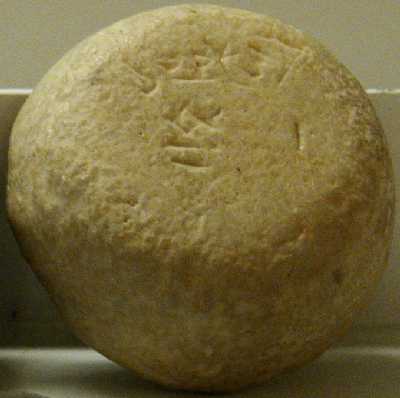
Not that I've memorized the Avigad/Sass corpus (WSS = "Corpus of West Semitic Stamp Seals"), but I've certainly thumbed through it enough that I did not recall ever seeing this specimen; & no, it's not really an ancient puck, but a weight that doubled as a personal seal! Naturally it was quite exciting to think that I might have rediscovered something of significance! The curator, Dr. Glenn Markoe, allowed me to take this photo so I could check it out when I returned home. I placed the object & its clay/putty impression side-by-side for a single shot using ambient lighting as best I could. Here's the other half of the photo:
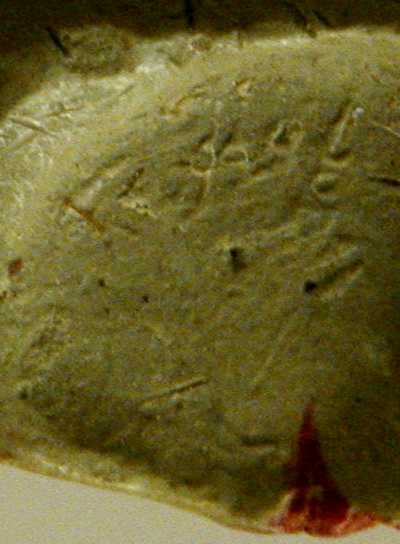
As we were examining it, I noticed the Bet-Resh ligature just like the LMLK H4C seal, line 14 of the KH1 silver scroll from Ketef Hinnom, line 5 of KH2, & lines 1 & 5 of the Siloam Tunnel inscription!
When we returned to his office, he was not able to find a record of it in CAM's computerized database, but he did find it in their good-old-fashioned paper card catalog. Here's what it said:
Seal and imprint
white stone seal "to Berechya (hu)"
3 x 3 cm.
published in BASOR 153, 1959
green clay imprint 3 x 4 cm.
8th - 7th Cent B.C.E. _ WGD
ON THE OLD LIST.
NOT ON THE NEW LIST.
The latter sentence in caps was handwritten on the card, & to the left was a nice shadow-photo of the object & impression. On a recent Sunday after the weekly worship service I attend in downtown L.A., I went to the Frances-Henry Library of the Hebrew Union College - Jewish Institute of Religion to check out this issue of BASOR (#153 was published in February, 1959). (This was the first week of their extended hours through the rest of the semester.)
I had searched online & thought I'd find it included in an article by R. B. Y. Scott, "The Shekel Sign on Stone Weights". Though the CAM placard doesn't mention it, you can clearly see a sheqel symbol below the inscription as well as 2 horizontal bars indicating a quantity of two. I didn't notice this until I scrutinzed the photo upon returning to L.A. from Cincinnati because of all the detrimental dings in the object. Here's my mock-up drawing:
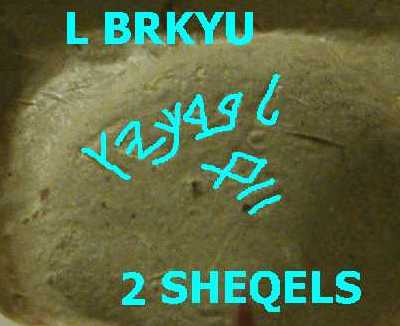
As it turns out, Scott's article on pp. 32-5 doesn't mention Rabbi Glueck's artifact, although he did mention the hypothesis that the sheqel symbol (an open-ended "8") at times substituted for "LMLK" based on the famous Gezer weight, but interprets it as "a conventionalized representation of the Hebrew seror, the tied bag or bundle in which lump silver & sometimes other valuables were carried." In a footnote, he cites Genesis 42:35, Proverbs 7:20, & Haggai 1:6, with metaphorical uses of $RUR in 1Samuel 25:29, Job 14:17, & Song 1:13. I would note that it's used with alternate semantics in 1Samuel 9:1, 2Samuel 17:13, Proverbs 26:8, & Amos 9:9. William Foxwell Albright added a comment that "the symbol is identical in form with Egyptian hieroglyphic & hieratic ss."
(By the way, when I chose the dollar sign to represent Tsadde in LMLK vol. 2, I had no idea it was the first letter of this word! It just seemed like a better way to combine "T" & "S" than the "X" I hastily chose in vol. 1.)
Two years later, Yigael Yadin published his dissention ("Ancient Judaean Weights & the Date of the Samaria Ostraca" in "Scripta Hierosolymitana vol. 8" edited by Chaim Rabin), hypothesizing that this "8" symbol evolved from the 4-winged scarab (the relevant section of his chapter is quoted on p. 186 of my LMLK vol. 1 book).
One of the reasons Prof. Scott speculated that the symbol represented a bag was its upward presentation on most weights as illustrated in his article. Too bad he didn't observe Rabbi Glueck's discovery on pp. 35-8, where it's shown horizontally like an open-ended infinity symbol--a spilled bag!
Nelson Glueck's article is totally excellent! He begins by describing the find spot in August, 1958 at Nebi Rubin overlooking the Mediterranean between Tel Aviv & Ascalon (though I cropped this modern map at Ashdod):
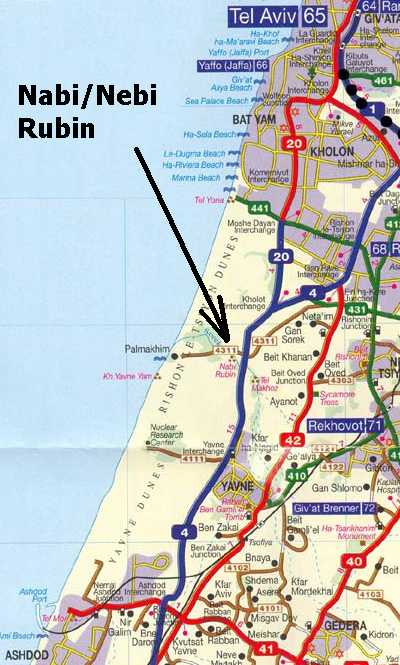
You can read the full text online if you have access to the JSTOR site, or you can see the first page here:
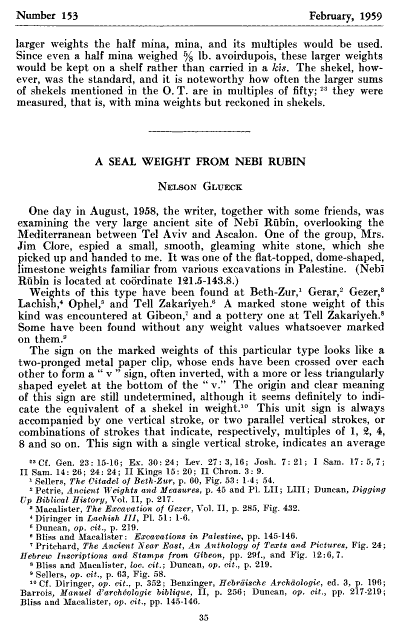
"Mrs. Jim Clore espied a small, smooth, gleaming white stone, which she picked up & handed to me. ... It has also generally been agreed that this class of weights is to be dated to the Persian & Hellenistic periods, to judge from the levels of the excavations in which they have been found. With this dating, the Nebi Rubin weight would seem to be in accord, because as our somewhat cursory examination of the surface remains on this tremendous site showed, there was nothing earlier. The main periods of occupation seem to extend from Hellenistic through Byzantine."
Then Glueck notes that the theoretical weight of the ancient sheqel is 11 grams, & this specimen weighs 21.894--almost exactly the expected amount considering the 2 horizontal bars indicating "2 sheqels". He also notes chisel marks on its underside (Fig. 3 shows them in his article), but I did not photograph the bottom since I didn't realize at the time that it was an ancient weight.
Next he focuses on the inscription:
"This particular Nebi Rubin weight is, furthermore, absolutely unique, so far as my knowledge goes, in that it is the only one of its kind bearing the name of its owner. On only one other similar weight is there an inscription."
That would be the aforementioned Gezer weight, which he describes plainly:
"Next to the two strokes are incised the ancient Hebrew consonants equivalent to l m l k, 'belonging to the king.'"
Then comes the descriptive transcription of his weight:
"...incised in sharply defined, retrograde, ancient Hebrew characters, which read l b r k y, as 'belonging to Berekay. It would seem that this Nebi Rubin weight could also have served as a seal, it being possible to use it to impress on wax or other material the owner's name right side up. It could therefore perhaps best be designated as a seal-weight, capable of fulfilling two functions, because otherwise it would have made no sense to incise the owner's name in retrograde. This feature heightens the uniqueness of this seal-weight, in contra-distinction to the known, normally written, inscribed weights, sucha as the l m l k one from Gezer, referred to above, & the earlier, Iron II b q ', n s f & p y m ones."
His closing paragraph cites Biblical usage of the name & orthography (Berechyahu or Berechyah per Glueck; Berachiah in the KJV), which I'll present here along with my own system:
- BRKYE in 1Chronicles 3:20
- BRKYEU in 1Chronicles 6:39 (or verse 24 in some Bibles)
- BRKYE in 1Chronicles 9:16
- BRKYEU in 1Chronicles 15:17
- BRKYE in 1Chronicles 15:23
- BRKYEU in 2Chronicles 28:12
- BRKYE in Zechariah 1:1
- BRKYEU in Zechariah 1:7
- BRKYE in Nehemiah 3:4
- BRKYE in Nehemiah 3:30
- BRKYE in Nehemiah 6:18
He notes:
"This would be in conformity with the probably Persian-Hellenistic date of the Nebi Rubin weight, with which its actual script, too, is in accord. The other references in I Chron. 6:24; 15:17.23 & II Chron. 28:12 occur in passages of post-exilic redaction. That does not mean, however, as indicated by II Chron. 28:12, that the name was not used in pre-exilic times, as well.
Of course a weight/seal datable to the late Judean monarchy may call his Hellenistic-Byzantine surface survey & post-exilic redaction into question, but I'm not aware of any extensive scientific excavations conducted at this site.
Notice in my drawing that there may have been another letter, a Vaw, after the Yod, rendering it as BRKYU. This form also appears in personal seals XXXa & XXXI as drawn & classified by Andrew G. Vaughn in BASOR 313 (February, 1999), or WSS 698/699 & 662 respectively. As Andy's illustration of these particular letters are speculative, compare also to my speculative drawing of the S2DR Vaw.
Bear in mind that my reconstruction of this final letter may be wrong--it may just be a coincidental alignment of dings. I admit it's an unlikely spelling, & the engraver would probably have begun the inscription farther to the other side so the final letter wouldn't end up on the edge of the already-calibrated weight.
Also I should mention that Rabbi Glueck omits Jesus naming Berachiah as the son of Zechariah (the prophet) in its Greek form in the New Testament letter of Matthew (23:35), nor does he offer its translation, which is "Blessed by God (Yahweh/Jehovah/LORD)".
To be continued...
Song of the week: "Free Money" by Sammy Hagar (click the song title to visit Amazon; click here for a 28-second sample; 361kb).
G.M. Grena

No comments:
Post a Comment